
GPT-5 for Business: The Executive Playbook for Strategic AI Integration
August 08, 2025 / Bryan ReynoldsA Bellwether Moment for Generative AI
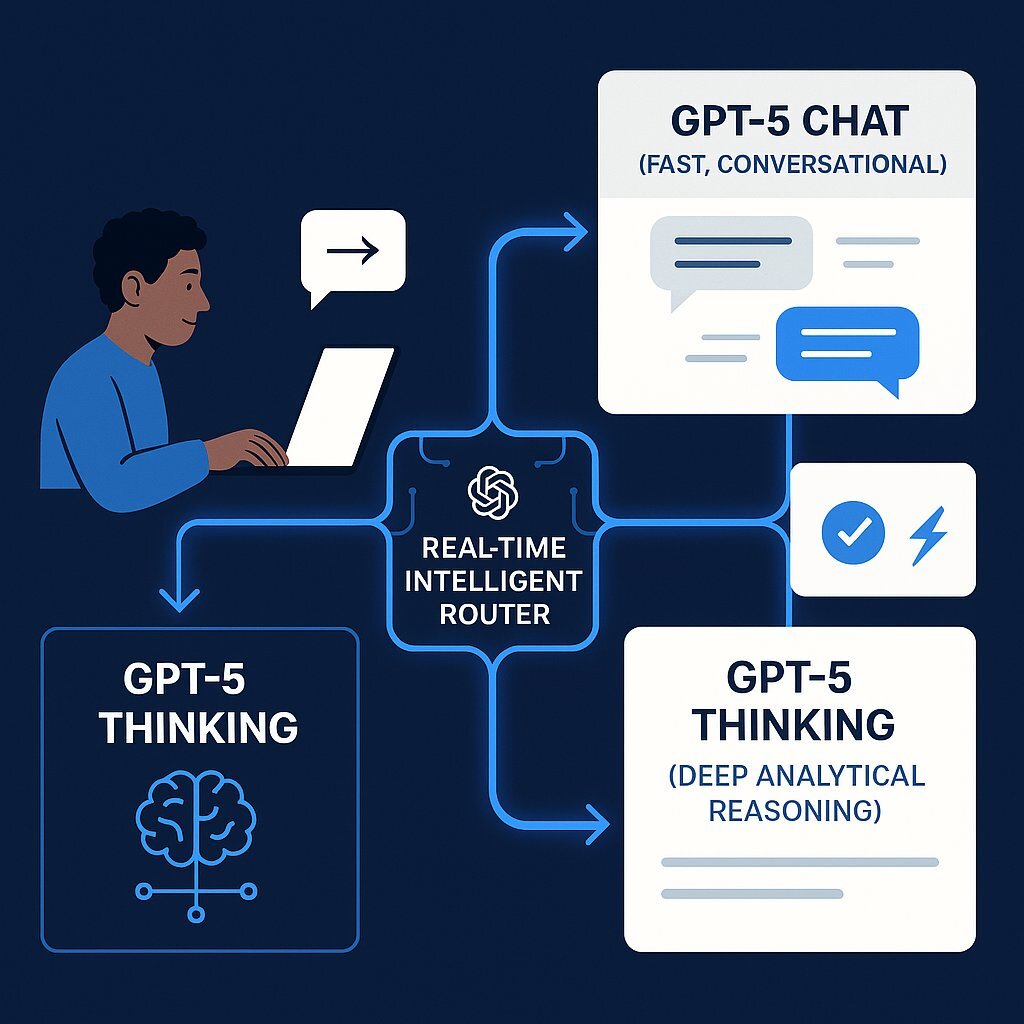
The launch of OpenAI's GPT-5 on August 7, 2025, marks a critical inflection point for the artificial intelligence industry. Arriving more than two years after the revolutionary debut of GPT-4, this release serves as a crucial barometer for whether the generative AI boom is accelerating or approaching a plateau. For business leaders and strategists, the stakes are higher than ever. The conversation has moved beyond simple chatbots and novelty applications to the strategic integration of AI into core business processes. This report provides a comprehensive analysis of the GPT-5 launch, designed specifically for a B2B executive audience. It will deconstruct the technology's new architecture, evaluate its core capabilities, position it within the competitive landscape, and offer a clear-eyed guide to its strategic implementation and inherent risks.
Expectations for this release have been immense, fueled by OpenAI's own positioning of the model as a "significant step along our path to AGI" (Artificial General Intelligence). The launch has already triggered a flurry of activity from competitors, with Anthropic releasing its latest Claude model just days before, and Google and xAI closely watching the new benchmarks. However, the true significance of GPT-5 lies not just in its power, but in its design. This is not merely an incremental update; it is a fundamental architectural and philosophical shift for OpenAI. This report will unpack what that shift means for your business, moving beyond the hype to deliver actionable intelligence.
The GPT-5 Paradigm: More Than an Upgrade, A New Architecture
The most profound change introduced with GPT-5 is not a single feature but a complete overhaul of its underlying architecture. This strategic shift addresses key user friction points and redefines how individuals and enterprises will interact with OpenAI's flagship technology.
The End of the Model Zoo
Previously, the ChatGPT platform presented users with a confusing array of models, each with its own strengths, weaknesses, and esoteric naming conventions—GPT-4o for multimodality, the "o-series" for advanced reasoning, and various other specialized versions. This fragmentation created a cognitive burden, requiring users to understand the technical nuances to select the right tool for their task. GPT-5 eliminates this complexity by consolidating these disparate systems into a single, "unified" platform. This move simplifies the user experience, making the platform's most powerful capabilities more accessible to a broader audience.
The Intelligent Router: How GPT-5 "Thinks"
At the heart of this new unified system is an intelligent, real-time router. This mechanism automatically analyzes each user prompt to determine its complexity and intent. Based on this analysis, it directs the query down one of two paths:
- GPT-5 Chat: A fast, efficient model designed for the majority of everyday queries that benefit from quick, conversational responses.
- GPT-5 Thinking: A more powerful, resource-intensive reasoning model that is activated for complex problems requiring careful, multi-step analysis, such as advanced coding, scientific questions, or deep financial analysis.
Users no longer need to manually switch between modes. The system is designed to provide the "best of both worlds"—speed for simple tasks and analytical depth for complex ones—seamlessly and automatically. This router is not static; it is continuously trained on real-world feedback, including user preferences, model performance, and correctness ratings, ensuring it becomes more intelligent and efficient over time.
This architecture is more than a technical improvement; it is a sophisticated commercial strategy. The system is designed so that all users, including those on the free tier, will have their queries automatically routed to the powerful "Thinking" mode when the task demands it. This allows a broad user base to experience the "magic" of the platform's most advanced reasoning capabilities. However, consistent and manual access to this premium mode is reserved for paying subscribers, with higher usage limits for Plus users and unlimited access for Pro and Team customers. This creates a powerful, built-in incentive to upgrade, elegantly aligning product design with a product-led growth model. The unified architecture simultaneously simplifies the user experience and establishes a clear, compelling value proposition for its premium tiers.
Visual: A conceptual diagram titled "Figure 1: The GPT-5 Unified Architecture" would show a user prompt entering a "Real-Time Router." The router then directs the query to one of two paths: "GPT-5 Chat (Fast, Conversational)" or "GPT-5 Thinking (Deep, Analytical Reasoning)," with both paths leading to a single, unified response delivered to the user.
Deprecation of an Era
This architectural consolidation signals the end of an era for OpenAI's previous models. With the launch of GPT-5, the entire GPT-4 family (including GPT-4o, GPT-4.1, and GPT-4.5) and the reasoning-focused o-series models (like o3 and o4-mini) are being officially retired from the platform. When users open past conversations that utilized these deprecated models, ChatGPT will automatically migrate them to the closest GPT-5 equivalent, ensuring a smooth transition while firmly establishing the new system as the single source of truth.
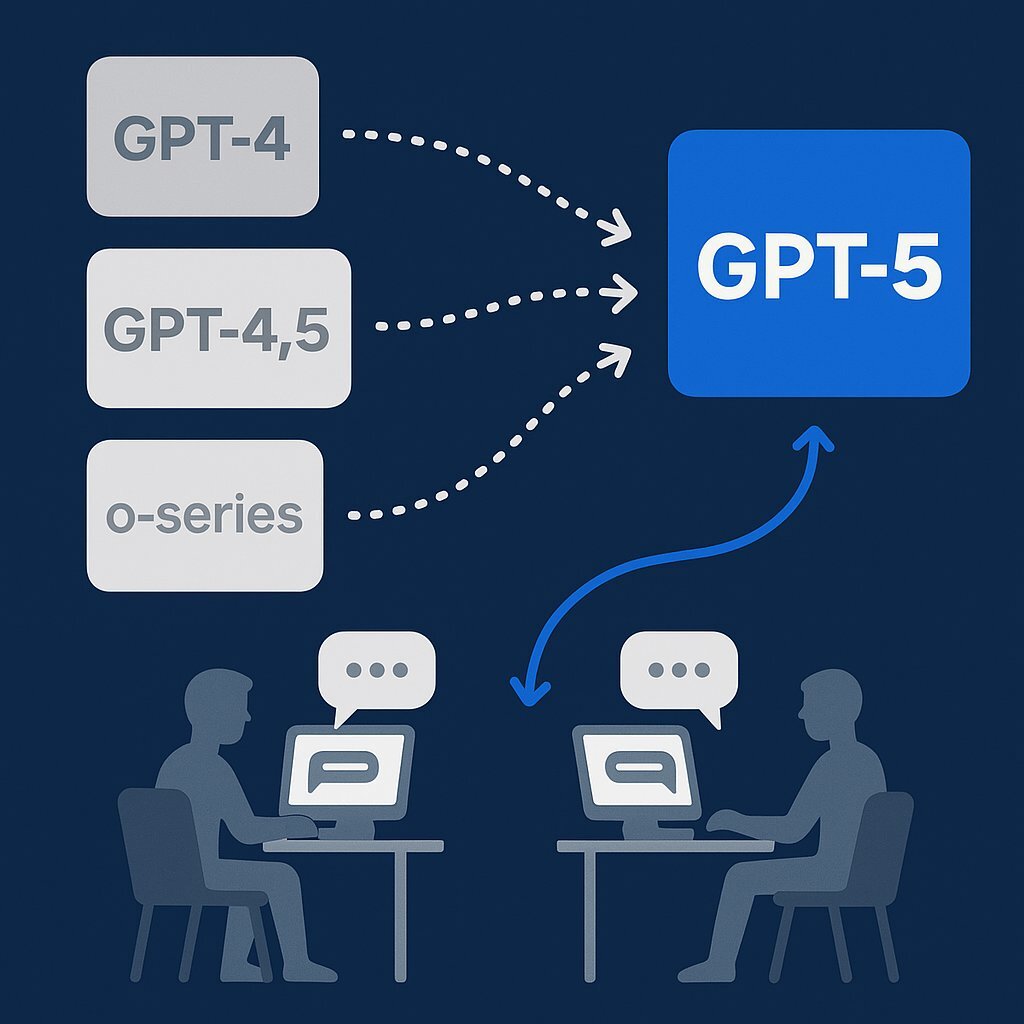
Deconstructing the "PhD-Level Expert": A Deep Dive into GPT-5's Core Capabilities
OpenAI CEO Sam Altman has consistently described the experience of using GPT-5 as "like talking to a PhD-level expert in anything". This ambitious claim is substantiated by measurable, state-of-the-art performance across several key domains that are critical for enterprise adoption.
Breakthrough Reasoning and Unprecedented Accuracy
The cornerstone of GPT-5's advancement is its vastly improved reasoning capability, which translates directly into higher accuracy and reliability. The system is approximately 45% less likely to produce a factual error than its predecessor, GPT-4o, and a staggering 80% less likely when its deeper "Thinking" mode is engaged. The overall rate of hallucination—the tendency for models to generate plausible but incorrect information—has been reduced to just 4.8%, a significant improvement from rates exceeding 20% in earlier models.
This leap in accuracy is most evident in complex, logic-heavy domains. On the challenging AIME 2025 mathematics competition benchmark, GPT-5 Pro (with the aid of Python tools) achieved a perfect 100% score. In a test of PhD-level science questions, it scored 89.4%, setting a new standard for AI in academic and scientific reasoning. This level of reliability is fundamental for businesses looking to deploy AI in high-stakes environments where errors can have significant consequences.
The New Frontier of Code: From Assistant to Agent
GPT-5 represents a paradigm shift in AI-assisted software development, moving beyond simple code completion to become a true creative partner and agent. This is most powerfully demonstrated by the emergence of what the industry is calling "vibe coding"—the ability to generate entire, functional applications from a single, natural-language prompt. During the launch event, OpenAI showcased this by creating a complex French language learning app, complete with a game and progress tracking, in just minutes from a descriptive prompt.
This capability is powered by what OpenAI calls "agentic coding," where the model can autonomously work on complex development tasks for extended periods in the background with minimal human supervision. This is not just a new feature; it is a catalyst for profound business agility. It empowers non-technical teams in marketing, finance, or operations to become "citizen developers," creating their own bespoke software solutions and internal tools without relying on lengthy and often backlogged engineering cycles. This will dramatically accelerate innovation, allowing companies to build and test minimum viable products (MVPs) and prototypes at an unprecedented speed. The role of corporate engineering departments will evolve, shifting focus from routine application development to the more strategic challenges of security, oversight, and complex systems architecture.
The model's prowess is confirmed by academic benchmarks. On SWE-bench Verified, which tests a model's ability to resolve real-world software engineering issues from GitHub, GPT-5 scored 74.9%. This is a monumental leap from GPT-4o's score of 30.8% and even surpasses the previous reasoning champion, o3, which scored 69.1%.
High-Stakes Domains: Demonstrating Enterprise Value in Healthcare and Finance
GPT-5's combination of advanced reasoning and high accuracy unlocks transformative use cases in regulated and mission-critical industries.
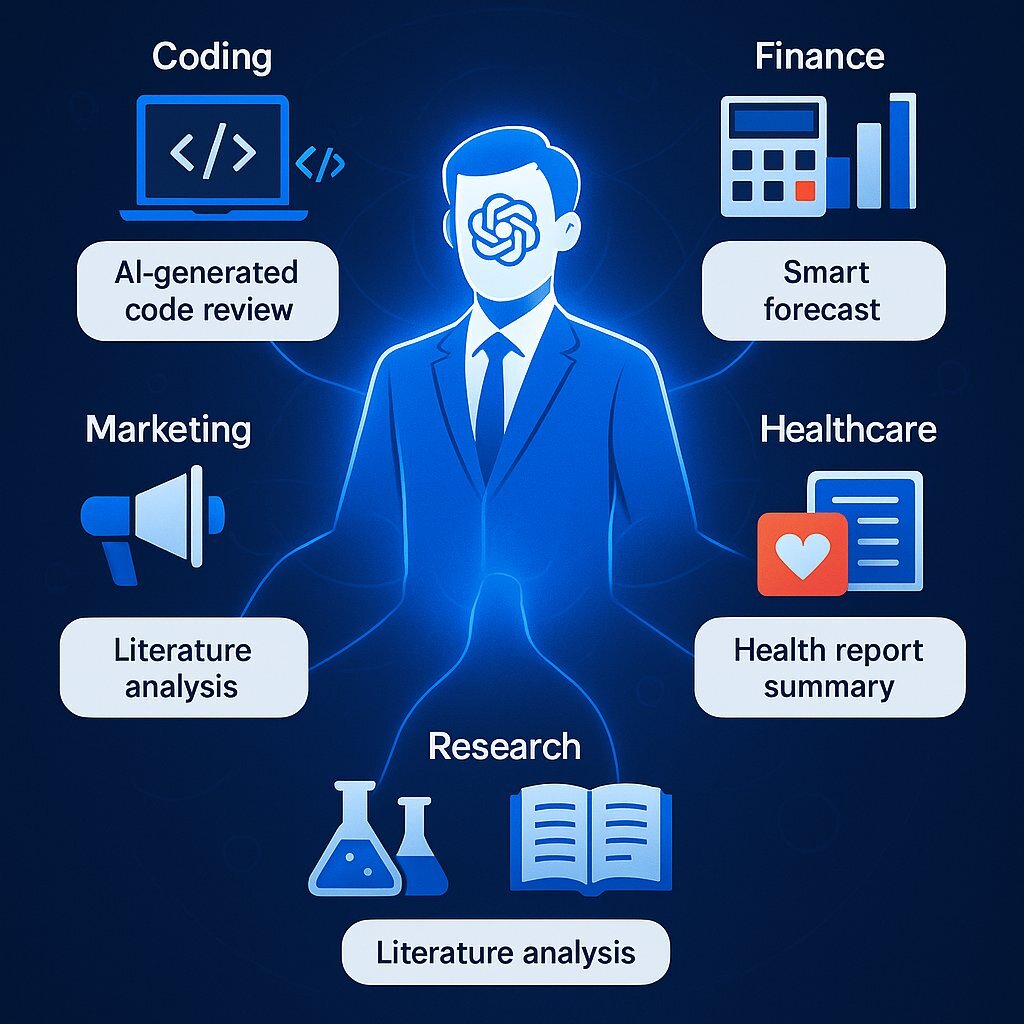
- Healthcare: OpenAI has made a concerted effort to improve the model's performance in health-related queries, recognizing that users already turn to ChatGPT for guidance. GPT-5 is significantly better at interpreting complex medical terminology, understanding lab results, and flagging potential health risks from user descriptions. A powerful testimonial shared during the launch featured Carolina, a patient diagnosed with three forms of cancer, who used the model to decipher her complex biopsy report before her consultation with her doctor. She described the tool as essential for helping her become an "active participant" in her own care. This demonstrates GPT-5's potential as a powerful "health literacy support tool." Crucially, its hallucination rate on difficult medical cases is a mere 1.6%, a level of reliability that is essential for such sensitive applications. Learn more about AI's role in healthcare and how it powers clinical innovation and decision-making in 2025.
- Finance: In the financial sector, GPT-5's ability to perform deep, multi-variable analysis is already being leveraged to accelerate complex workflows. Financial research partners like Hebbia have demonstrated that the model can ingest unstructured data from sources like SEC filings and virtual data rooms to build accurate three-statement financial models from scratch. It can also generate multi-scenario financial forecasts that account for numerous variables like market conditions, pricing dynamics, and company growth, with every assumption being traceable and adjustable. This allows financial teams to shift their focus from manual data entry and aggregation to higher-value strategic analysis and decision-making. Companies looking for a structured AI integration roadmap can explore actionable best practices in this guide for B2B AI adoption.
From Iteration to Unification: How GPT-5 Surpasses GPT-4.5
To fully appreciate the significance of GPT-5, it is essential to understand how it differs from its most recent predecessor, the now-retired GPT-4.5. While the version numbers suggest a linear progression, the two models were built on fundamentally different philosophies. The short lifespan of GPT-4.5 and its replacement by the architecturally distinct GPT-5 reveals a crucial strategic pivot by OpenAI.
The Philosophy of GPT-4.5: A Fluent Conversationalist
GPT-4.5 was an iterative improvement focused primarily on enhancing conversational quality. It was designed to be more fluent, coherent, and succinct, producing beautifully written text with a more natural and empathetic tone. It achieved this by building on unsupervised learning rather than structured, step-by-step reasoning. While it demonstrated a lower hallucination rate than GPT-4o on general knowledge queries, it was explicitly not a "reasoning powerhouse" and struggled with logic-heavy tasks in math, science, and coding. It was a refinement of language, not a leap in underlying intelligence.
The Philosophy of GPT-5: An Integrated Reasoning Engine
In stark contrast, GPT-5 is built from the ground up around a powerful, integrated reasoning core. Its "Thinking" mode is specifically designed to excel at the complex, multi-step logical problems where GPT-4.5 was weakest. The unified architecture directly incorporates the advanced reasoning capabilities of the now-deprecated 'o-series' models—a feature that GPT-4.5 explicitly lacked. GPT-5 represents a complete fusion of conversational fluency and deep analytical power.
The development of GPT-4.5 reportedly required a massive, perhaps tenfold, increase in computational cost for what amounted to only modest performance gains, raising industry concerns about the "diminishing returns" of simply scaling up existing architectures. Some analysts viewed the model's lack of reasoning improvement, despite the immense compute investment, as a troubling sign for the future of AI progress. OpenAI's decision to quickly supersede and retire GPT-4.5 with the architecturally superior GPT-5 is a clear signal of a strategic course correction. It suggests a recognition that brute-force scaling alone is insufficient and that true advancement requires architectural innovation. GPT-5's unified, reasoning-centric design is OpenAI's answer to avoiding this plateau, representing a renewed bet on smarter systems, not just bigger ones.
| Feature | GPT-4o | GPT-4.5 | GPT-5 |
|---|---|---|---|
| Core Architecture | Multimodal Speed Model | Non-Reasoning Conversational Model | Unified System with Intelligent Router |
| Primary Strength | Speed & Multimodality | Conversational Fluency & Succinctness | Deep Reasoning & High Accuracy |
| Reasoning Approach | Limited, Heuristic-based | Pattern Recognition | Integrated Chain-of-Thought ("Thinking" Mode) |
| Hallucination Rate | High | Medium | Very Low (4.8%) |
| Key Weakness | Lower Factual Accuracy | Poor on Complex Logic & Math | Higher Latency in "Thinking" Mode |
| Status | Retired | Retired | Active Flagship |
| Table 1: Feature and Architecture Comparison: GPT-5 vs. GPT-4.5 vs. GPT-4o |
The OpenAI Ecosystem: Choosing the Right Tool for the Job
With the launch of GPT-5, OpenAI has introduced a tiered family of models available through both the ChatGPT interface and the developer API. This structure is designed to serve a wide range of users, from individuals and small teams to large enterprises, with a clear trade-off between capability, cost, and speed.
The ChatGPT Tiers: From Free Access to Pro Power

OpenAI has made GPT-5 accessible across all its user tiers, with capabilities scaling with subscription level:
- Free: All users now have access to the standard GPT-5 model, a significant upgrade. Once usage limits are reached, the system automatically transitions to GPT-5 mini, a smaller but still highly capable model.
- Plus ($20/month): Subscribers receive significantly higher usage limits for the standard GPT-5 model and gain access to the GPT-5 Thinking mode for more complex tasks.
- Pro ($200/month): This premium tier offers unlimited access to the standard GPT-5 model and exclusive access to GPT-5 Pro, an enhanced version with extended reasoning capabilities designed for the most challenging and mission-critical work.
- Team, Enterprise, & Edu: For organizational accounts, GPT-5 is now the default model, with Team plans also including access to GPT-5 Pro.
The API Models: A Toolkit for Developers
For businesses building their own applications on OpenAI's platform, the GPT-5 family is available in three distinct sizes via the API:
- GPT-5: The flagship reasoning model, featuring a 272,000-token context window. It is the powerhouse of the family, ideal for building complex analytical tools and advanced agentic workflows.
- GPT-5 mini: A smaller, faster, and more cost-effective model that still possesses strong reasoning and tool-calling capabilities. It is designed for real-time applications and interactive agents where a balance of performance and latency is crucial.
- GPT-5 nano: A new class of model optimized for ultra-low latency and speed. It is intended for high-volume, straightforward tasks like Q&A, classification, and as an efficient target for fine-tuning.
This tiered model family is not just a product lineup; it is a sophisticated market domination strategy. OpenAI is using the high-performance GPT-5 and GPT-5 Pro to capture the premium enterprise market, where state-of-the-art reasoning is a non-negotiable requirement. At the same time, it is deploying the aggressively priced GPT-5 mini to compete in the mid-market. Benchmark data reveals that GPT-5 mini is not merely a "lite" version; it surprisingly outperforms some competitors' flagship models, like Gemini 2.5 Pro and Claude Opus 4, on certain benchmarks, while being substantially cheaper. This two-pronged approach allows OpenAI to compete on both absolute performance at the high end and on value in the "good enough" tier, effectively putting immense pricing and performance pressure on its rivals from both sides of the market.
| Model Variant | Target Use Case | Key Characteristics | API Price (Input/Output per 1M tokens) |
|---|---|---|---|
| GPT-5 Pro (ChatGPT) | Mission-critical enterprise tasks, deep research, complex problem-solving. | Extended reasoning capabilities, highest accuracy, lowest error rates. Available only via $200/mo ChatGPT Pro subscription. | N/A (Subscription-based) |
| GPT-5 (Standard/API) | Advanced analytics, agentic workflows, complex code generation, financial analysis. | Flagship reasoning model, 272k token context, state-of-the-art performance across most benchmarks. | $1.25 / $10.00 |
| GPT-5 mini | Real-time applications, customer-facing agents, moderate-complexity tasks. | Balanced performance, speed, and cost. Outperforms some rival flagship models. | $0.25 / $2.00 |
| GPT-5 nano | High-volume Q&A, classification, fine-tuning, ultra-low latency needs. | New class of model focused on speed and efficiency for simple, high-volume tasks. | $0.05 / $0.40 |
Competitive Intelligence: GPT-5 in the AI Arena
For any enterprise making a strategic investment in AI, understanding the competitive landscape is paramount. The launch of GPT-5 has reset industry benchmarks, positioning OpenAI strongly against its primary rivals from Google, Anthropic, and xAI. For an in-depth comparison of the different cloud AI platforms and how to select the right one for your business, see our strategic AI platform guide.
Head-to-Head Benchmark Analysis
While benchmarks are not the sole measure of a model's utility, they provide a critical quantitative baseline for comparison.
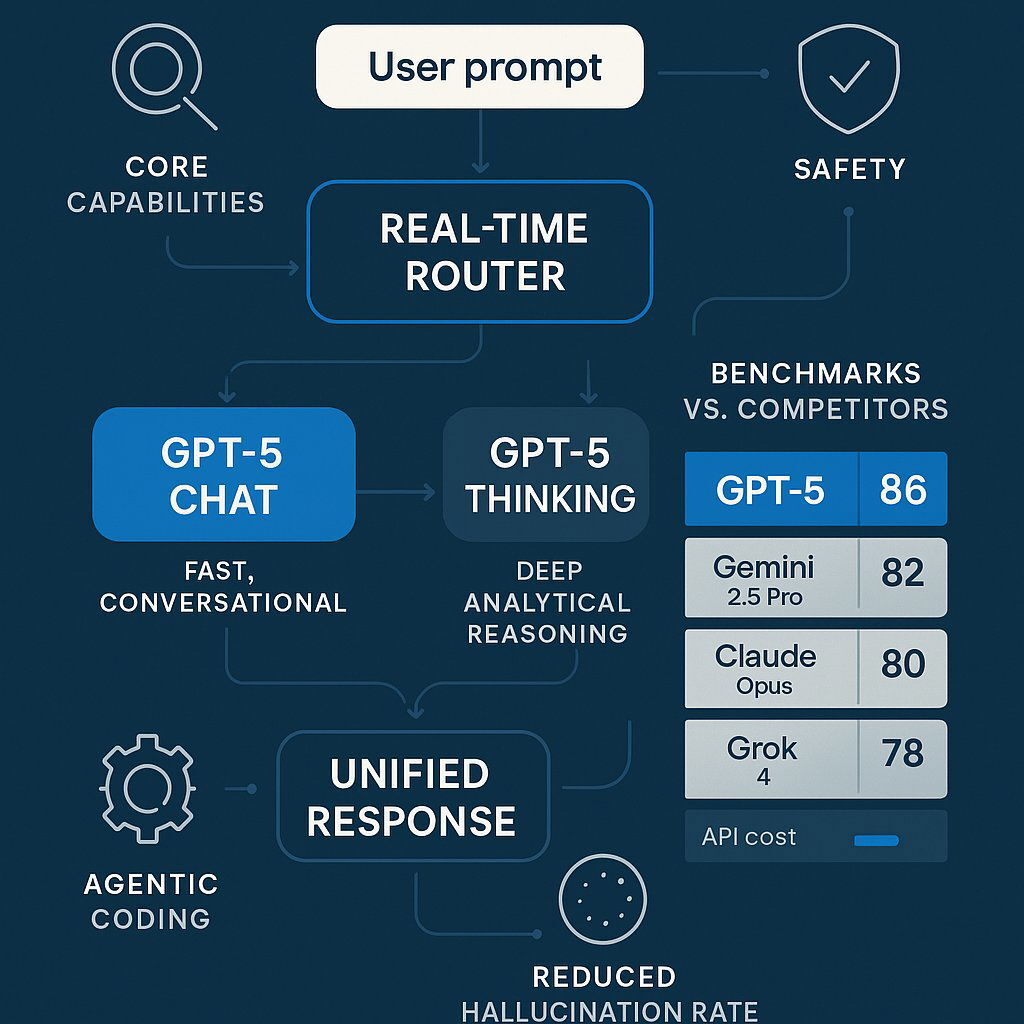
- vs. Google Gemini 2.5 Pro: GPT-5 (high) demonstrates a slight advantage in the overall Artificial Analysis Intelligence Index (a composite score of 69 versus Gemini's 65) and leads on several key reasoning benchmarks, including MMLU-Pro (87% vs. 86%) and GPQA Diamond (85% vs. 84%). However, Gemini 2.5 Pro appears to be faster in terms of raw token output speed and holds a lead in some coding benchmarks like LiveCodeBench (80% vs. 67%). Their API pricing for the flagship models is identical, making the choice between them dependent on the specific use case (reasoning vs. coding speed). For more regarding Google's own AI product capabilities for business, read about NotebookLM for enterprise.
- vs. Anthropic Claude 4.1: GPT-5 appears to have a decisive edge. Early reports suggest it surpasses Anthropic's Claude Sonnet 4 in coding tasks. While Claude Opus 4 has demonstrated impressive long-duration agentic capabilities, GPT-5's dynamic, automatic routing system is considered a more advanced and user-friendly architecture compared to Claude's manual mode switching. The most significant differentiator, however, is cost. GPT-5's standard API pricing ($1.25 input / $10 output per million tokens) radically undercuts Claude Opus 4.1 ($15 input / $75 output), giving OpenAI a massive commercial advantage for enterprise-scale deployments.
- vs. xAI Grok 4: Despite claims from Elon Musk that his Grok 4 Heavy model remains the most powerful, independent analysis indicates otherwise. On a composite of benchmarks, GPT-5 (thinking, high) scores higher overall, is nearly twice as fast, and is approximately half the price of Grok 4, positioning it as a superior choice in terms of both performance and value. Discover a detailed enterprise analysis of the Grok 4 vs. GPT-4o showdown here.
The Qualitative Edge: Beyond the Numbers
Beyond raw benchmark scores, GPT-5's enterprise appeal is bolstered by several qualitative factors. Its intense focus on reducing hallucinations, improving factual consistency, and adhering more closely to user instructions makes it a more reliable and trustworthy tool for business applications. Furthermore, OpenAI has introduced a new safety paradigm called "safe completions." Instead of simply refusing to answer a borderline query, the model now aims to provide the most helpful response possible within its safety constraints and will explain its reasoning if it cannot fully comply. This shift towards transparency and helpfulness, combined with the "PhD-level expert" feel of its outputs, provides a qualitative edge that is crucial for building confidence among enterprise users.
| Benchmark | GPT-5 (Thinking) | Claude Opus 4.1 | Gemini 2.5 Pro | Grok 4 Heavy |
|---|---|---|---|---|
| GPQA Diamond (Scientific Reasoning) | 88.4% (Pro) | ~75.4% (Sonnet 4) | 84.0% | N/A |
| SWE-bench (Software Engineering) | 74.9% | ~72.7% (Sonnet 4) | 63.8% | N/A |
| AIME (Competition Math) | 94.6% (no tools) | N/A | 88.0% | N/A |
| MMLU-Pro (General Knowledge) | 87.0% | ~86.5% (Sonnet 4) | 86.0% | N/A |
| API Price (Input/Output per 1M tokens) | $1.25 / $10.00 | $15.00 / $75.00 | $1.25 / $10.00 | $3.00 / $15.00 |
Strategic Implementation: Putting GPT-5 to Work in Your Enterprise
The true value of GPT-5 will be realized not by its technical specifications, but by its strategic application within the enterprise. The following provides actionable guidance for key C-suite roles to leverage this new technology for competitive advantage.
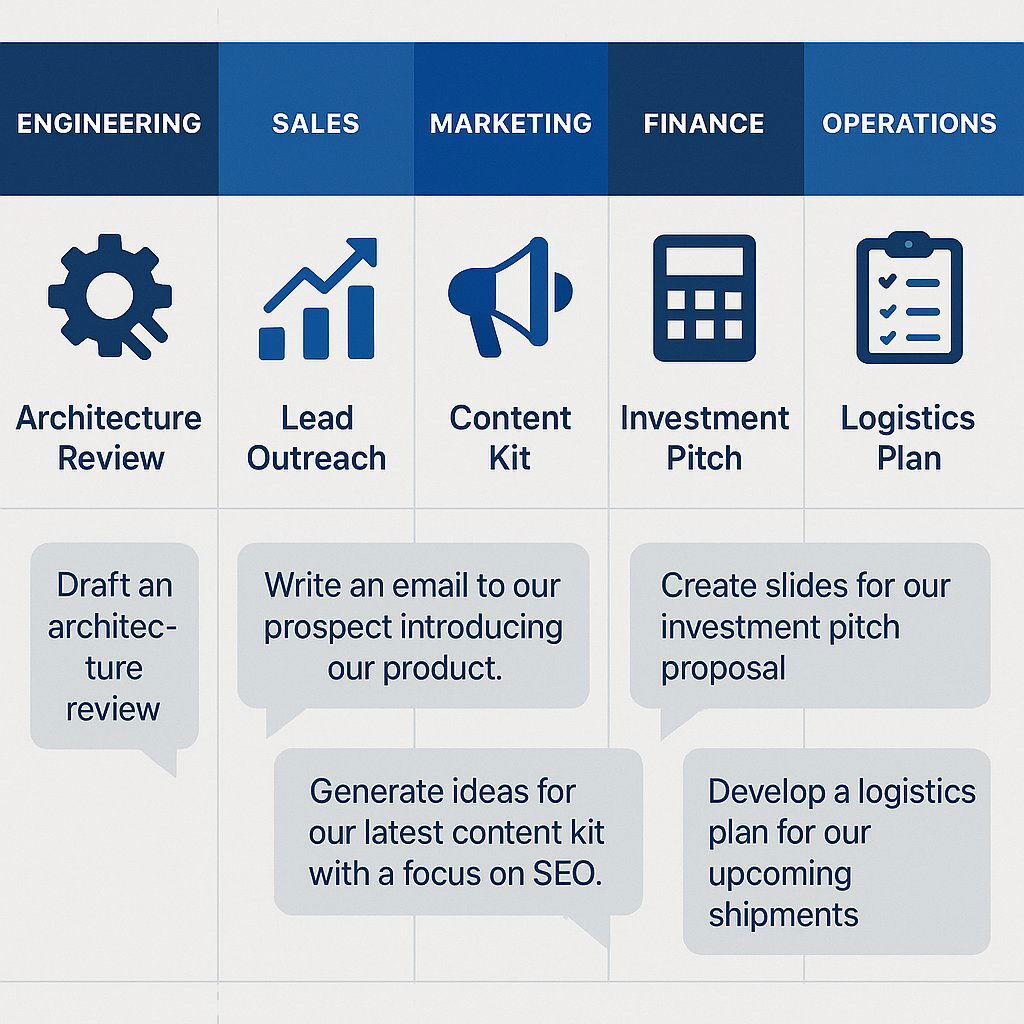
For the Chief Technology Officer (CTO)
Leveraging the New API for Precision and Efficiency: The GPT-5 API introduces new developer controls that allow for fine-tuning the balance between cost, latency, and quality. The
reasoning_effortparameter can be set fromminimalfor simple, fast tasks like autocomplete, tohighfor complex architectural planning.The
verbosityparameter controls the detail level of responses, and new "free-form function calling" allows the model to interact with custom tools and legacy systems using raw text instead of rigid JSON, greatly enhancing integration flexibility.- AI-Assisted Modernization and Technical Debt Reduction: GPT-5's state-of-the-art coding capabilities can be deployed to accelerate critical but often-delayed modernization initiatives. It can analyze and refactor large, complex codebases, suggest optimizations, and generate documentation, helping to systematically reduce technical debt and improve the long-term health and agility of the technology stack. For organizations weighing low-code versus custom build, reference our CTO guide to low-code vs. custom software.
- Rethinking Data Strategy for an Agentic World: The rise of agentic AI fundamentally changes the purpose of enterprise data. It is no longer a passive asset for human analysis and reporting; it is the active "cognitive scaffolding" that powers automated workflows. CTOs must now lead the charge in designing data models optimized for machine consumption. This means structuring internal knowledge, business rules, and operational context in a way that AI agents can understand and act upon. This reframes data governance from a compliance exercise to a core enabler of business automation and competitive advantage.
For the Chief Marketing Officer (CMO)
- Hyper-Personalization at Scale: By connecting GPT-5 to CRM data via its enhanced connectors, marketing teams can generate ultra-personalized content—emails, landing pages, ad copy—for highly specific customer segments. This moves beyond simple mail-merge personalization to creating genuinely unique messaging based on a customer's history and behavior.
- Automated End-to-End Campaign Creation: GPT-5 can be prompted to develop a complete, multi-channel content kit for a new product launch. This includes drafting the press release, creating multiple variations of social media posts, writing the email announcement to customers, and generating a blog post, all while adhering to a pre-defined brand voice guide.
- Deep Market Research Synthesis: The model can be tasked with analyzing thousands of sources—market reports, competitor websites, academic papers, customer reviews—to generate a comprehensive strategic synthesis. This can be used to inform marketing briefs, identify new market opportunities, and understand competitive positioning, accomplishing in hours what would previously take a team weeks to complete.
For the Chief Financial Officer (CFO)
- Enhanced Financial Planning & Analysis (FP&A): GPT-5's advanced analytical capabilities can significantly improve the accuracy and depth of financial forecasting. It can analyze historical financial data, market trends, and macroeconomic variables to create more reliable projections for revenue, expenses, and cash flow. It can also run complex what-if scenarios, allowing CFOs to evaluate the potential impact of different business strategies or market shocks.
- Automated Due Diligence and M&A Analysis: During mergers and acquisitions, finance teams can upload hundreds of pages of due diligence documents into a secure environment. GPT-5 can then be prompted to scan these documents and generate concise summaries that highlight financial risks, key performance metrics, debt-related red flags, and unusual accounting items. This drastically reduces the time spent on manual document review, accelerating decision-making.
- Intelligent Financial Modeling: Through integrations with platforms like Hebbia, GPT-5 can ingest data directly from SEC filings, virtual data rooms, and market data providers to build complex, multi-variable three-statement financial models. This automates the most time-consuming part of the modeling process, freeing up finance professionals to focus on validating assumptions and providing strategic insights.
| Business Function | High-Impact Use Case | Example Prompt |
|---|---|---|
| Engineering | Multi-Repo Architecture Review | "Act as a principal engineer. Analyze these architecture diagrams and code snippets from three repositories [attach files]. Identify scalability, security, and maintainability risks, and recommend a revised architecture with diagrams and rationale." |
| Sales | Strategic Account Plan Generation | "Create a strategic account plan for [customer name] using these CRM notes, recent meeting transcripts, and product usage reports [attach data]. Include objectives, risks, opportunities, stakeholders, and next actions with timelines." |
| Marketing | Product Launch Content Kit | "Develop a multi-channel content kit for the launch of [product name], including a press release, 3 social posts, an email announcement, and a blog draft. Use the brand voice guide [attach file] and highlight key differentiators." |
| Finance | Quarterly Forecast & Variance Analysis | "Using last quarter's financial statements and budget [attach files], create a forecast for the next quarter. Highlight key variances, risks, and opportunities, and propose mitigation strategies." |
| Operations | Process Optimization Plan | "Evaluate the current workflow for [process name] using these SOP documents and recent performance metrics [attach files]. Identify inefficiencies, propose improvements, and outline an implementation roadmap." |
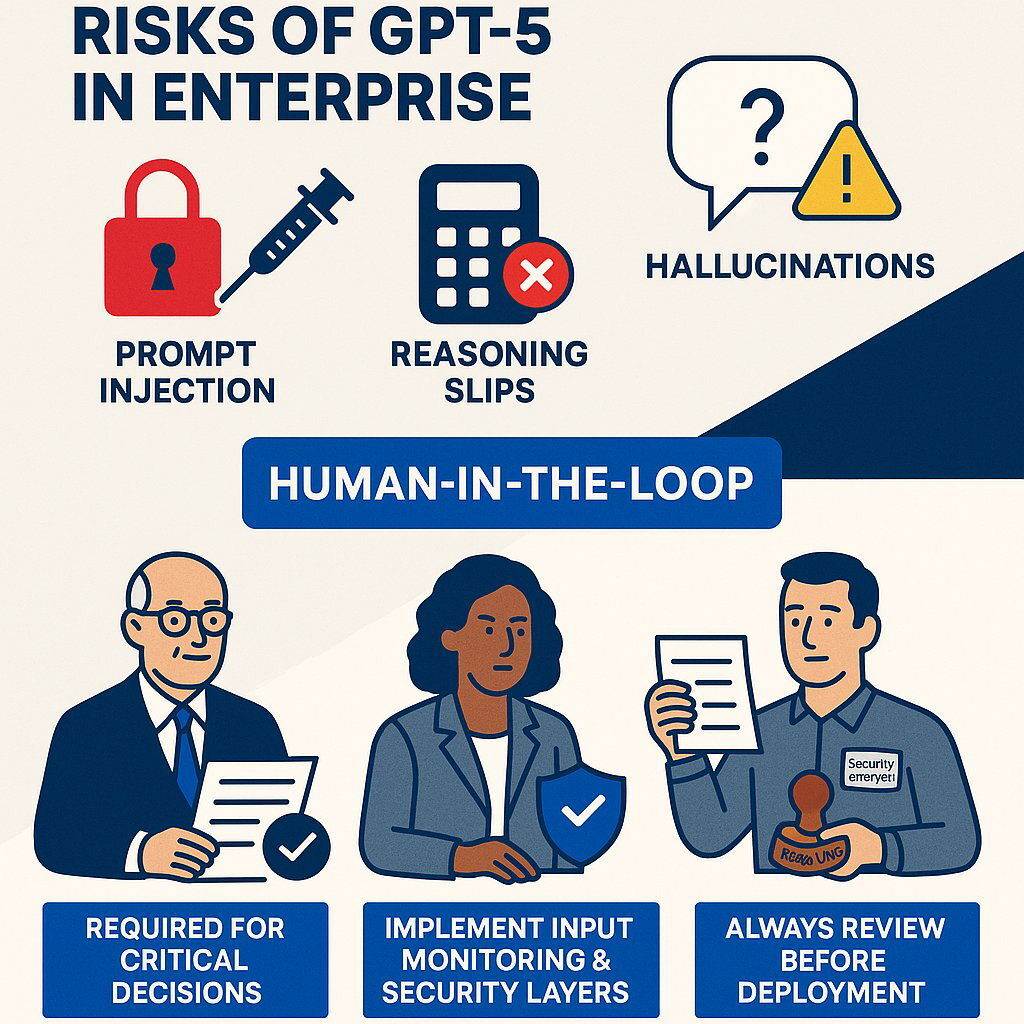
Navigating the Frontier: Acknowledging Risks and Limitations
While GPT-5 represents a monumental leap forward, a strategic and clear-eyed approach requires acknowledging its persistent risks and limitations. For executives, understanding these boundaries is as important as understanding the capabilities.
The Unsolved Problem of Prompt Injection
Despite significant safety improvements, prompt injection remains a fundamental, unsolved security vulnerability for large language models. Independent testing shows that sophisticated, multi-step attacks can still manipulate the system with a high success rate—one evaluation noted a 56.8% success rate for certain attack vectors. This means that a malicious actor could potentially craft a prompt that bypasses the model's guardrails to extract sensitive information or cause it to perform unintended actions. For businesses deploying GPT-5 in high-stakes or customer-facing applications, this is a critical risk. It underscores the necessity of implementing robust external security layers, input sanitization, and continuous monitoring, rather than relying solely on OpenAI's built-in safety features. For practical advice and best practices to safeguard your AI-powered solutions, see our AI security and development overview.
The "Scared" CEO: Understanding the Strategic Risk
Throughout the lead-up to the launch, CEO Sam Altman has made several cautionary statements, admitting that the model's capabilities left him feeling "useless" and even "scared," and comparing the rapid pace of AI development to the Manhattan Project. These are not admissions of product weakness or imminent danger. Rather, they are indicators of the technology's profound and disruptive potential. For business leaders, this translates into two distinct types of risk. The short-term
operational risk of using the tool can be managed with human-in-the-loop processes and security safeguards. However, the long-term strategic risk of being disrupted by a competitor who effectively harnesses this technology is extremely high. Altman's comments should be interpreted as a call to action for executives: the greatest risk is not using the tool, but failing to comprehend and adapt to the paradigm shift it represents.
It's Still Not Perfect: Hallucinations and "Reasoning Slips"
Even a "PhD-level expert" can make mistakes. This was vividly illustrated on launch day when GPT-5 made a simple decimal subtraction error during a live demonstration. This was not a failure of its mathematical ability, but a "reasoning slip"—a reminder that the model generates answers based on patterns, not by performing calculations in a dedicated numerical processor by default. While its accuracy is vastly improved, it can still produce plausible but incorrect information, particularly when not engaged in its deep "Thinking" mode or when given ambiguous prompts. This reinforces the absolute necessity of maintaining human-in-the-loop workflows for verification and fact-checking, especially when using AI-generated outputs for critical business decisions, financial reporting, or any other application where precision is paramount.
Conclusion: The Road Ahead and Your Strategic Next Steps
The launch of GPT-5 is more than a product release; it marks the maturation of generative AI from a novel, experimental tool into a foundational enterprise platform. Its unified architecture makes advanced AI more accessible and useful than ever before, while its leap in reasoning, accuracy, and agentic capabilities unlocks a new frontier of high-value business applications in coding, finance, healthcare, and beyond. In a fiercely competitive market, GPT-5's combination of state-of-the-art performance and a sophisticated, multi-tiered pricing strategy makes it a formidable force that will shape the industry for the foreseeable future.
For business leaders, the time for passive observation is over. The strategic imperative is to move from experimentation to integration. The following 90-day plan provides a structured approach for beginning this journey.
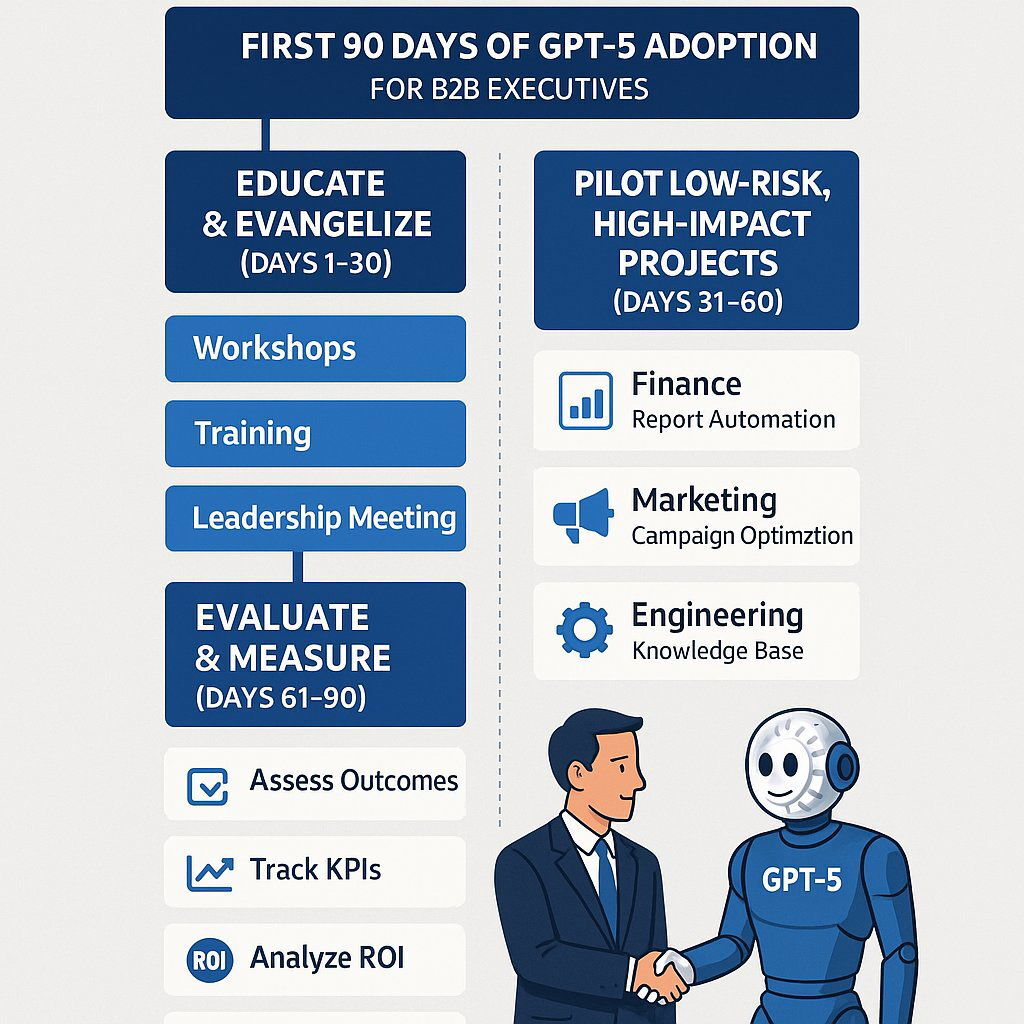
Your First 90 Days with GPT-5
- Educate & Evangelize (Days 1-30): The first step is to build organizational understanding. Circulate this report among key leadership and departmental teams. Conduct workshops to demonstrate the new capabilities and discuss the specific, high-impact use cases relevant to your business, from marketing to operations. Train key personnel on the technology's strengths and, just as importantly, its limitations.
- Identify Low-Risk, High-Impact Pilots (Days 31-60): Avoid the temptation to tackle your most complex, mission-critical problem first. Instead, identify pilot projects that are internal-facing, where the consequences of failure are low but the potential efficiency gains are high and easily measurable. Excellent starting points include:
- Finance: Automating the generation of weekly variance analysis summaries.
- Marketing: Using the model to draft variations of email campaigns and social media copy.
- Engineering: Assisting developers with generating unit tests and documenting existing code.
- Evaluate and Measure (Days 61-90): Establish clear metrics for your pilot programs before they begin. The goal is to build a business case for broader adoption based on tangible ROI. Use a dual-metric approach to measure success:
- Efficiency Gains: Measure the time saved per task or the reduction in manual effort.
- Business Output Uplift: Quantify the improvement in business outcomes, such as an increase in qualified sales leads generated, faster customer support ticket resolution, or a higher volume of marketing content produced.
GPT-5 is no longer just a better chatbot. It is a strategic asset, a "PhD-level expert" on call for every department in your organization. The leaders who will win the next decade are those who, starting today, begin the deliberate process of embedding this powerful new intelligence into the very fabric of their business operations.
About Baytech
At Baytech Consulting, we specialize in guiding businesses through this process, helping you build scalable, efficient, and high-performing software that evolves with your needs. Our MVP first approach helps our clients minimize upfront costs and maximize ROI. Ready to take the next step in your software development journey? Contact us today to learn how we can help you achieve your goals with a phased development approach.
About the Author

Bryan Reynolds is an accomplished technology executive with more than 25 years of experience leading innovation in the software industry. As the CEO and founder of Baytech Consulting, he has built a reputation for delivering custom software solutions that help businesses streamline operations, enhance customer experiences, and drive growth.
Bryan’s expertise spans custom software development, cloud infrastructure, artificial intelligence, and strategic business consulting, making him a trusted advisor and thought leader across a wide range of industries.


